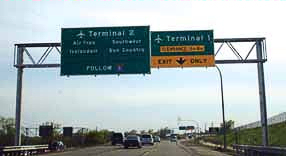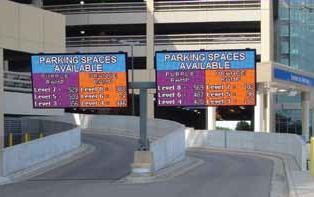Highway Signs Modified to Clarify Twin Cities Confusion
Driving into Minneapolis-St. Paul International Airport (MSP) used to be a challenging and sometimes frustrating experience. But the Metropolitan Airports Commission is working to make that a thing of the past with a $1.4 million signage program executed last fall and winter.

Two private access roads, leading to the airport's two separate terminals (Lindbergh and Humphrey), were at the root of the confusion. As customers approached MSP, many didn't know which terminal their airline was in. If they guessed incorrectly, they'd have to get back on the highway and backtrack about a mile to re-enter the airport at the other terminal.
The Metropolitan Airports Commission estimates that 20,000 to 30,000 travelers went to the wrong terminal each year, often missing their flight as a result.
"People couldn't find their way to the correct terminal," relates Gary Warren, director of airport development for the airports commission. "In some regards, it was like we had two airports."
The Humphrey Terminal was added in 2001, and was previously used for charter flights. A year ago, however, Southwest Airlines began operating scheduled service out of Humphrey.
 Signs leading into MSP were labeled International Airport, Lindbergh Terminal and Humphrey Terminal - with no indication of which carriers flew out of each terminal.
Signs leading into MSP were labeled International Airport, Lindbergh Terminal and Humphrey Terminal - with no indication of which carriers flew out of each terminal.
The hitch, explains Warren, is that the Federal Highway Authority does not allow branded signs to be used along highways; listing specific company names is tantamount to advertising. Showing lists of carriers on the signs also raised concerns over the amount of information the signs would need to convey. The more there is to read on a sign, the more dangerous it can be, explains Warren.
After ten years of confusion, the airports commission and Minnesota Department of Transportation set out to improve the signs on the highways leading to MSP.The state DOT, which fielded its own share of complaints from confused travelers, was a great ally getting the project done, notes Warren - especially in working with the Federal Highway Authority.
The Fix Is In
In 2009, the Metropolitan Airports Commission gained approval from the highway authority to change the signs to include airline listings. To add flexibility, the signs were manufactured with slide-out slots that can be replaced as airlines serving each terminal change, explains Jeff Boser, special projects manager at Lyle Signs.
 To comply with restrictions on the amount of information that can be conveyed on the signs, the airports commission agreed to split the airline names among three separate signs and to identify the terminals by number rather than their historic names.
To comply with restrictions on the amount of information that can be conveyed on the signs, the airports commission agreed to split the airline names among three separate signs and to identify the terminals by number rather than their historic names.
It took a full year for the design of the new signs to be approved by the airports commission. "A key part of the solution came down to not putting too much information on the signs," recalls Warren.
On the new signs, the Lindbergh Terminal is identified only as Terminal 1, and the Humphrey Terminal as Terminal 2. Officially, the terminals will retain their historic names and be designated elsewhere as Terminal 1-Lindbergh and Terminal 2-Humphrey.
A maximum of six airlines are listed on each sign, and the airlines are listed in alphabetical order. In all, 43 new sign panels were modified in 44 areas, reports Warren.
Construction
Contracts for the project were awarded in fall 2009; foundation work for the signs began shortly thereafter. With winter approaching, it was important to get the guardrails and foundations installed by the end of December, recalls Brandon Bourdon, P.E., project engineer at Kimley-Horn & Associates. The project stayed on schedule, Bourdon reports, and the last base was installed on Dec. 23.
|
Facts & Figures Project: Location: Airport Operator: Metropolitan Airports Commission Cost: $1.4 million Scope: Project Engineer: Kimley-Horn & Associates Contractor: Sign Manufacturer: Lyle Signs Traffic Control: Benefits: New signs list airlines in each terminal to alleviate confusion entering the airport. |
Staying on schedule pouring the foundations helped keep the rest of the project on schedule. "Once the signs and sign structures were delivered, everything stayed on schedule almost to the day," recalls Bourdon. "Overall, the project was on schedule; all changes were transparent. This project just fell into place."
The signs themselves needed to be completed by March. According to Boser, Lyle had about two or three months to manufacture the signs and deliver them to the contractor. "We shipped all the signs to them before they started construction so there wasn't a materials matter holding them up," he explains.
All construction work was done at night to limit the amount of traffic and some of the dangers involved with working in a high-speed, high-traffic area. "It's always dangerous [working on the interstate], but it is important to keep our guys, the H&R guys and the traveling public safe," says Reed Leidle, project manager from Safety Signs. Safety Signs worked with H&R Construction to control the traffic while crews installed the new signs.
Although working at night minimized the traffic and inconvenience, notes Bourdon, it's easier for contractors to work in natural light.
Temporary signs that informed airport visitors of the upcoming terminal name modifications were posted until June 15, notes Leidle. "People had all the information they needed to get to the right terminal during the remaining process," he relates.
"Everything went well," relates Boser. "It was engineered well, the setup was good and the plans were good."
Leidle identifies planning as a key component: "Part of the reason this project was so well executed was because it was easy to bid on, easy to implement and well planned throughout."
Bourdon attributes the project's success to good collaboration. "The way everyone communicated and worked together made it a good project," he says.
H&R Construction is continuing its work at MSP with a two-phase project inside the airport.
No News Is Good News
"The biggest challenge was just getting through the process," recounts Warren.
During tough economic times, the project's original $2+ million budget was an "easy target" for the news media and internet bloggers, he explains. In the end, however, the project cost $1.4 million - about $800,000 less than anticipated, and none from public funds. Metropolitan Airports Commission paid for the entire project.
 Cost aside, many critics doubted that the new signs would make a difference. "People didn't think changing Humphrey to Terminal 2 was going to change anything," says Warren. "They didn't get that our goal wasn't to get the names down. Our mission was to get the airline names up on the highway system."
Cost aside, many critics doubted that the new signs would make a difference. "People didn't think changing Humphrey to Terminal 2 was going to change anything," says Warren. "They didn't get that our goal wasn't to get the names down. Our mission was to get the airline names up on the highway system."
Public reaction to the new signs has been anticlimactic. "We were pleasantly surprised once the signs went up," he notes. "We've heard very little feedback. We usually don't get calls from folks when something goes right, but we expect to see a reduction in the number of complaints. That will be satisfying!"
|
New Electronic Signs Help Airport Visitors Navigate Parking Options In addition to new highway signs directing travelers into Minneapolis-St. Paul International Airport (MSP), electronic signs were added in its newest parking garage and special event parking for the light rail station last summer. The new full-color variable message signs (VMS), supplied by Daktronics, provide way-finding information such as available spots, available levels and directional information to customers approaching the garage.
Interfacing the new signs with the existing parking sign system was one of the project's challenges, reports Todd Lambert, aviation market manager for Daktronics. The controller software and display capabilities of the signs, however, allow for a multitude of display and programming options, notes Kowalke. Daktronics had a leg up on ensuring consistency with other airport signs because it previously installed ProStar color signs at MSP's exit plazas. The new system allows messages to be displayed on several signs at the same time, which is important when multiple signs are installed adjacent to each other with the same alternating messages, explains Gary Warren, director of airport development for the airports commission. Different sign types are used at different airport locations depending on their anticipated use and the age of the installation, adds Warren.
Concerns regarding the multimode fiber used at the airport, which is different than the type Daktronics typically uses, were resolved long before the project was bid, notes Kowalke. The design team reviewed the fiber lengths to ensure that the communication system would work as designed but created a backup plan that would have included the installation of additional data distributors along the fiber runs to repeat the communication signals if necessary. The system worked as planned, however, and the backup plan was not required. The seven-month VMS sign project was completed in August 2009.
A larger ground-mounted sign located at a key decision point provides way-finding messages to direct travelers to the correct location. The signs are designed to allow for the activation of routine messages to occur with the push of a button, notes Kowalke. If a special situation arises, however, the airports commission can easily modify the messages from several locations throughout the airport campus, he adds. This allows the commission to present critical information to the traveling public in a very short amount of time. Providing real-time information to customers as they enter the airport helps alleviate stress often associated with traveling, notes Lambert. |
FREE Whitepaper
Fairbanks International Airport Baggage Transport Conveyor Enhanced With Mod Drive™ System
Airports face a host of unique industry challenges, such as meeting efficiency regulations and seeking out the best maintenance practices to reduce costs and keep operations flowing. In today’s current economic climate, any potential cost savings can go a long way.
In 2019, Alaska’s Fairbanks International Airport (FAI) sought to modernize its equipment and operations. They were dissatisfied with the performance of the gearmotors on their baggage transport conveyors and began searching for new suppliers. Regal approached FAI with a solution that could improve equipment performance and simplify maintenance, with the added benefit of energy cost savings: the Hub City® MOD Drive™ system.
This white paper discusses the hardware deployed, the test results and the annualized expectations for ROI.
 "These particular signs have more capabilities in terms of programming," notes Dennis Kowalke, project manager for the Metropolitan Airports Commission.
"These particular signs have more capabilities in terms of programming," notes Dennis Kowalke, project manager for the Metropolitan Airports Commission. Daktronics worked with the airport and project engineer Kimley-Horn to address communication and fiber network issues and to maintain balanced control of the system.
Daktronics worked with the airport and project engineer Kimley-Horn to address communication and fiber network issues and to maintain balanced control of the system. The full-color LED signs make messages stand out more than traditional static signing, explains Kowalke. VMS at the base of the Terminal 2 entry helix to the parking ramps present the numbers of parking stalls that are available on each level, which allows the traveling public to choose the level that has the most parking available. Signs installed over the lanes allow for particular messages to be displayed for each entry and exit lane.
The full-color LED signs make messages stand out more than traditional static signing, explains Kowalke. VMS at the base of the Terminal 2 entry helix to the parking ramps present the numbers of parking stalls that are available on each level, which allows the traveling public to choose the level that has the most parking available. Signs installed over the lanes allow for particular messages to be displayed for each entry and exit lane.







